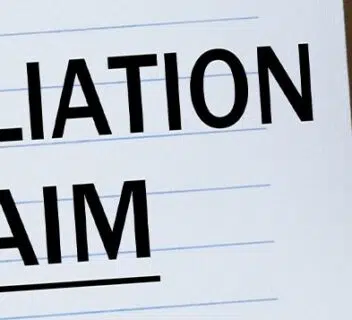Hostile working conditions involve persistent harassment and abuse that make it tough to work effectively. This article will walk you through key signs, legal aspects, and ways to address and improve such environments.
If you believe you have experienced hostile working conditions, contact 1-800-THE-LAW2 today for a free consultation with an attorney in our network.
Key Takeaways
- A hostile work environment is characterized by persistent harassment, discrimination, and abusive behaviors that hinder employee performance and well-being.
- Identifying signs of a hostile workplace, such as bullying, exclusion, and aggressive behavior, is crucial for taking timely action to address and mitigate these issues.
- Addressing hostile conditions involves clear communication, seeking support, and understanding the legal protections available to employees, alongside fostering a positive workplace culture.
Understanding Hostile Working Conditions

A work environment becomes hostile when pervasive harassment, aggression, or abuse arises due to unwelcome conduct often connected with an individual’s protected characteristics. As outlined by OSHA, such antagonistic behavior establishes an oppressive atmosphere where illegal harassment and discrimination occur simultaneously, making employees feel uneasy and inhibiting their job performance.
The following are indicators of a hostile workplace:
- Continuous instances of harassment
- Acts of discrimination
- Experiences of victimization
- Incidents involving violence
- Various other offensive behaviors
These actions might be repetitive in nature or may involve a singular extreme event that can profoundly impact the mental state and professional output of an employee. This includes incidents that occur only once.
Rather than trivial nuisances, these conditions indicate deep-rooted problems within the work setting which contribute to a poisonous workplace atmosphere. Identifiable factors including race, color religion, sex national origin disability age genetic information among others frequently underpin such inhospitable workplaces. Ensuring early detection is essential for remediation efforts aimed at enhancing company culture.
Identifying Hostile Working Conditions
Recognizing a hostile workplace environment requires an awareness of certain behaviors and signs that contribute to such a setting. These signals often consist of:
- Intimidating or bullying practices
- Spreading rumors or gossiping
- Ostracism or exclusionary tactics
- Various forms of miscommunication leading to discomfort among employees
These types of conduct foster an unwelcoming work atmosphere, which can hinder employees from focusing on their tasks and performing at their best.
Persistent unwelcome behavior is typically indicative of a hostile work environment. This may manifest as verbal abuse, discriminatory actions, and aggressive interactions between individuals within the workplace. By identifying these harmful patterns early on, it becomes possible to intervene promptly and address the problematic behaviors before they worsen—thereby preventing the establishment of a hostile workplace for employees.
Consistent Unwelcome Conduct
Repeated exposure to unwelcome conduct is indicative of a hostile work environment. Actions such as bullying and verbal abuse can seriously erode an employee’s sense of self-assurance and well-being. Persistent conduct, like relentless criticism and overbearing supervision, may leave employees feeling devalued and tense.
Being continuously subjected to this type of hostility has the potential to lead to enduring stress and even anxiety disorders. Burdening an employee with tasks that are outside their skill set or employing derogatory slurs and humor also plays a role in fostering a toxic workplace.
It is crucial for the health of the work environment that these types of behaviors are recognized swiftly and dealt with effectively in order to preserve a positive atmosphere within the workplace.
Discriminatory Practices
Unfair practices that target specific individuals or demographics are a strong indication of a hostile work environment. This includes policies that disproportionately disadvantage certain employees, such as mistreatment based on age or unfair actions related to pregnancy. The use of racially insensitive language, even in jest, can contribute to creating a hostile atmosphere and lead to employment discrimination.
A workplace becomes toxic when there is an ongoing display of behavior that discriminates against people through derogatory comments, slurs, and so-called humorous remarks aimed at particular groups or persons. Age-related humor and the devaluation of someone’s input due to their age are additional forms of discriminatory conduct indicative of a hostile environment.
It’s imperative for companies to confront these problems head-on in order to foster an organizational culture where respect and inclusivity are paramount.
Aggressive Behavior
Verbal assaults, bullying methods, and passive-aggressive maneuvers are all examples of aggressive behavior that can surface in a work environment. When leaders engage in overcritical or micromanagement, it may foster an atmosphere of intimidation, which erodes the confidence and spirit of employees.
These antagonistic behaviors pose not just a threat to employee morale, but also impede teamwork and diminish productivity within the workplace. Identifying these indicators and taking steps to counteract them is crucial for cultivating a supportive and constructive workplace atmosphere.
Examples of Hostile Working Conditions
Illustrative cases of hostile work environments can shed light on this issue, with typical indicators being formal allegations of harassment or discrimination, unwelcome sexual overtures, solitary instances of discourtesy or mockery, and confrontational actions such as oral assaults. Such a toxic work atmosphere may result in mental distress that adversely affects an employee’s efficiency. Stressed employees often find it challenging to maintain their standard job performance. These examples can elucidate the nature of a hostile workplace.
Elements like excessive rivalry among colleagues or prevalent ‘bro culture’ could play a significant role in fostering a hostile environment for workers. Recognizing these scenarios is vital for pinpointing and rectifying comparable problems within one’s own workplace setting.
Sexual Harassment
Sexual harassment constitutes a form of hostile behavior that encompasses unwelcome sexual advances, solicitations for sexual favors, and the making of sexual jokes. Such persistent conduct from male colleagues can generate an environment of intimidation for female employees, impeding their ability to feel secure and respected in their workplace.
The proliferation of improper remarks and humor exacerbates the antagonism within the work setting, contributing to feelings of “lack of safety” among employees and diminishing their job performance. It is crucial to combat harassment by instituting unambiguous procedures and providing education in order to cultivate an atmosphere at work characterized by respect and security.
Racist or Offensive Comments
Racial slurs or demeaning jokes, even when made in jest, can foster a hostile work environment by promoting discrimination, as defined under regulations such as the Law Against Discrimination (LAD). Such continuous and deliberate offensive behavior creates a toxic workplace atmosphere that leads to discomfort among employees.
Refusing promotions or withholding salary increments due to an employee’s religious convictions is indicative of discriminatory conduct that exacerbates the hostility within the work environment. To cultivate an environment of respect in the workplace, it is vital to confront these problems with definitive policies and practices that uphold inclusivity.
Age and Disability Discrimination
Discrimination based on age and disability plays a substantial role in creating hostile work environments. This may manifest through the denial of employment opportunities due to someone’s age, overlooking senior employees for advancement, or coercing them into retirement. Instances, where supervisors belittle an employee by making disparaging remarks regarding their age or discounting their suggestions as outdated, are explicit forms of discrimination related to age.
In the case of employees with disabilities, encountering ongoing taunts, scornful jokes, or being tasked with assignments that are beyond their physical capabilities can lead to a poisonous workplace atmosphere. Tackling these kinds of discriminatory behaviors is crucial in developing a work environment that is both welcoming and considerate toward all staff members.
Legal Aspects of Hostile Working Conditions
Understanding the legal aspects of hostile working conditions is crucial for both employees and employers. Harassment becomes unlawful when it is a condition of employment or it creates an intimidating, hostile, or abusive work environment. Victims of workplace discrimination under federal law have 180 days to file an employment discrimination claim, while in various states, they may have several years to file a claim in Superior Court.
Victims may seek monetary compensation and damages for pain and humiliation. They might also pursue attorney’s fees, punitive damages, and job reinstatement. Additionally, employees have protection from retaliation under the EEOC when they file a complaint about workplace hostility. These legal protections help employees navigate and address hostile work environments effectively.
What Constitutes Illegal Behavior?
Engaging in harassment within the workplace is considered illegal when it pertains to an employee’s race, color, religion, sex (including pregnancy), national origin, age (40 or older), disability, or genetic information. Unwelcome conduct that disrupts and adversely influences the work environment may also be deemed unlawful under the Civil Rights Act.
Workplace bullying could potentially fall into the category of illegal activity if it aligns with certain conditions outlined by employment legislation. It’s imperative for employees to have a comprehensive understanding of what actions are classified as illegal so they can recognize their rights and respond effectively when encountering hostile behavior at work.
Reporting and Documentation
It is crucial to report and meticulously document instances of hostile behavior in order to manage and resolve such conflicts. Maintaining comprehensive records with specific dates, times, and any potential witnesses will support the foundation for pursuing legal remedies.
Should you encounter discrimination within your workplace, adhering to certain procedures can safeguard your ability to pursue a legal complaint. It’s vital that you substantiate your notification of hostile conduct by providing written confirmation to either human resources or an employer and keep detailed accounts of all interactions with management on the matter. This documentation could prove indispensable if recourse through internal mechanisms proves unsuccessful.
How to Address Hostile Working Conditions
It is essential to confront hostile work conditions immediately. A swift response includes alerting the individual, whose actions are considered unwelcome by a reasonable person, and actively seeking solutions as soon as such a hostile environment becomes apparent.
Employees must be aware that they possess avenues for remedying their circumstances and aren’t obligated to remain in an untenable position. They should refrain from provoking or engaging in any form of hostility they come across.
Communicating Concerns
Establishing transparent procedures for reporting harassment is essential to make sure that employees can raise concerns without fear and feel supported. Should an employee endure hostile conduct from a supervisor, they should report it either to the higher-level supervisor or the human resources department.
If toxic behavior is observed, it’s important to meticulously document both the conduct itself and any actions undertaken in response. This documentation will be crucial in addressing the issues effectively.
Seeking Support
Turning to peers, mentors, and specialized services for guidance can offer both emotional comfort and actionable suggestions on how to cope with hostile work environments. These individuals may share insights or coping mechanisms from their personal encounters with similar situations.
Should the hostility continue unabated, initiating a Charge of Employment Discrimination might result in corrective measures taken by the U.S. Equal Employment Opportunity Commission. Seeking help from professional counseling services could assist one in working through these incidents and cultivating resilience against discrimination.
Considering Legal Action
Should other strategies not yield results, pursuing legal action becomes an important consideration. It’s unlawful to retaliate against employees who lodge claims, and the initiation of a Charge of Employment Discrimination may commence the judicial process. It is essential to report any aggressive behavior in the workplace that endangers one’s physical well-being.
In situations where hostile work environments are perpetuated by upper management, gathering evidence related to employee performance and attrition rates can create a strong argument for taking necessary measures against discrimination.
Impact of Hostile Working Conditions on Mental Health
Employees may experience significant mental health issues, such as stress, depression, and anxiety when exposed to a hostile work environment. Such environments can provoke feelings of fear and apprehension that not only affect their well-being but also spill over into their personal lives.
Stress and Anxiety
Stress and anxiety are common impacts of hostile working conditions. Employees often experience feelings of fear, helplessness, and distress, severely affecting their overall well-being. Persistent stressors from unwelcome conduct contribute to chronic anxiety among employees.
Common symptoms of workplace anxiety include:
- irritability
- difficulty concentrating
- headaches
- sleep disturbances
Employees should seek support from colleagues, supervisors, or mental health professionals to cope with these stressors.
Decreased Work Performance
Employees subjected to unwelcome conduct in the workplace often struggle with maintaining their focus and task performance, leading to a decline in both productivity and job satisfaction. The mental stress created by such hostile work environments can have detrimental effects on an employee’s ability to make decisions effectively.
It is essential for employers to acknowledge that a toxic workplace has significant consequences on workers’ output and act swiftly to rectify these situations. By cultivating a supportive and respectful atmosphere within the workplace, employers can mitigate the negative impact of hostility on employees’ performances.
Creating a Positive Workplace Culture

Fostering a positive culture within the workplace is crucial to circumventing environments that can be perceived as hostile. By setting fundamental values and embracing a policy with no tolerance for harassment, workers are empowered to report any such incidents in a safe atmosphere. Conducting consistent anti-harassment training coupled with team-building exercises bolsters cooperation and interaction among employees.
The promotion of inclusivity and mutual respect among staff members results in better collaboration, creativity, and an enhanced work environment overall. To cultivate an even more inclusive workforce that mirrors diverse experiences, employers ought to incorporate diversity initiatives into their hiring processes.
Anti-Harassment Training
Ongoing anti-harassment training is crucial in educating employees on behaviors that are not tolerated, thereby fostering a work environment rooted in respect. It’s important that this training isn’t seen as a singular occurrence, but rather as a repeated effort to continually endorse respectful behavior.
This form of instruction plays an essential role in making sure employees are aware of what constitutes harassment and upholding the standards of conduct within the workplace. By doing so, it helps create a more secure and nurturing environment for everyone at work.
Clear Policies and Procedures
It is essential that all employees are consistently informed about the protocols for reporting harassment through regular communication of effective policies. These clear guidelines and processes offer a structure to manage hostile behaviors, while also enabling employees to voice their concerns with confidence that there will be no repercussions.
When a single individual is responsible for fostering a hostile work environment, it’s crucial they face termination or disciplinary actions in order to preserve a constructive culture within the workplace. Having explicit policies aids in executing prompt and fitting responses to confrontations arising from hostility.
Promoting Inclusivity
Encouraging an inclusive environment at the workplace means appreciating and embracing diverse viewpoints, which boosts engagement among employees. Building inclusivity can be achieved by consistently organizing team-building events designed to strengthen bonds between employees from diverse backgrounds.
In essence, championing inclusivity and fostering respect contributes to better collaboration, creativity, and a more affirmative culture within the workplace. It is crucial for employers to endeavor to establish a nurturing atmosphere that accommodates every employee.
Summary
Acknowledging the presence of and tackling adverse working conditions are essential for sustaining a work environment that is both productive and beneficial to well-being. It’s important for employees alongside their employers to be aware of the indicators pointing towards a hostile atmosphere, comprehend the legal implications, and take preventive measures in curbing these detrimental behaviors. A concerted effort to foster an encouraging workplace culture can result in heightened employee morale and increased efficiency, as a welcoming work environment holds advantages for all involved parties. Contact 1-800-THE-LAW2 today for a free consultation with an attorney in our network if you believe you have experienced a hostile work environment.
Frequently Asked Questions
What constitutes a hostile work environment?
A work environment becomes hostile when employees are consistently subjected to intimidation, hostility, or harassment that targets their protected characteristics, creating an unpleasant atmosphere.
Such continuous conduct erodes the safety and sense of ease in the workplace.
How can I identify a hostile work environment?
To identify a hostile work environment, look for signs such as bullying, gossip, exclusion, verbal abuse, discriminatory actions, and aggressive behavior that disrupt employee well-being and productivity.
If you notice these patterns, it may indicate a toxic workplace.
What are some examples of hostile working conditions?
Hostile working conditions can manifest as sexual harassment, racist comments, discrimination based on age or disability, unwanted sexual advances, and aggressive verbal attacks.
These behaviors create a toxic environment that can significantly impact employee well-being and productivity.
What legal protections are available for employees in a hostile work environment?
Employees in a hostile work environment are legally protected from retaliation under the EEOC when they file complaints. Additionally, they may seek monetary compensation, damages, attorney’s fees, and potential job reinstatement through a lawsuit.
How can employers create a positive workplace culture?
Employers can foster a positive workplace culture by implementing anti-harassment training, promoting inclusivity, and establishing clear policies that support a respectful and supportive environment.
Prioritizing these elements will cultivate a healthier, more productive workplace.

